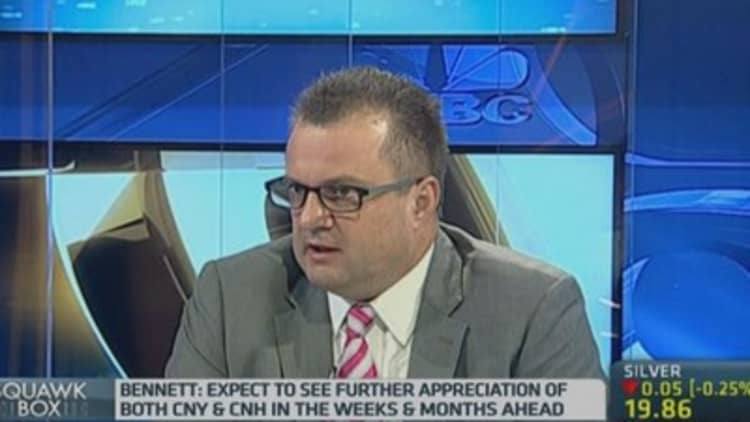The amount of money flowing into China's economy slowed to the lowest level in nearly six years in July, adding to fears that a sustained recovery may be at risk in the second half of the year despite government efforts to shore up growth.
Both the central bank and economists had expected some payback in July after unexpectedly strong financing data in June, but new loans and money supply growth were far below economists' expectations.
China's total social financing (TSF) aggregate, a broad measure of liquidity in the economy, fell to 273.1 billion yuan ($44.34 billion) in July, about one seventh of that in June and the lowest monthly reading since October 2008 in the depths of the global financial crisis.
The People's Bank of China took the unusual step of issuing a statement immediately after the data, reassuring markets that credit and financing growth was still reasonable and that it had not changed its monetary policy.
Read MoreWill this be a breakout year for Chinese stocks?
Still, it conceded the slowing economy, and in particular the cooling property market, were dampening loan demand and highlighted the risks of pumping too much money into a softening economy too quickly, citing the growing number of bad loans.
Non-performing loans have now risen for 11 straight quarters, the central bank's statement said.
"It's surprising. On the face of it, we've not observed any tightening of monetary conditions by policymakers," said Louis Kuijs, an economist at Royal Bank of Scotland in Hong Kong.
"I don't know if this has anything to do with disagreements between policymakers. In its recent monetary policy report, the central bank warned of continued risks in fast credit lending."
Read MoreOver 150 Chinese 'economic fugitives' at large in US
Chinese banks made 385.2 billion yuan ($62.53 billion) worth of new yuan loans in July, down sharply from 1.08 trillion yuan in June and well below expectations of 727.5 billion yuan, central bank data showed on Wednesday.
The People's Bank of China said in its second quarter policy report earlier this month that it will maintain reasonable growth in credit and social financing and fine-tune its monetary policy in a timely way.
But it also sounded a cautious note by saying that bank credit is already too large and it needs to be mindful of inflationary risks.
That echoed analysts' concerns about how much of June's loan surge was going into real economic activity and how much may be going into speculative activities.

Broad M2 money supply rose 13.5 percent last month from a year earlier, the People's Bank of China said in a statement on its website, www.pbc.gov.cn, lower than the forecast 14.4 percent rise.
Outstanding yuan loans grew 13.4 percent from a year earlier versus forecasts for growth of 14.0 percent.
Beijing stepped up efforts to re-energize China's economy in June, pumping more money into the system and pressing banks to extend more loans. Those steps and other stimulus measures earlier in the year appear to have offset the drag from a weakening property sector and sluggish exports, but analysts say more support may be needed to sustain a recovery.
China's main stock index, the , reversed early gains and fell 0.8 percent after the credit data was released.
Read MoreChina's July trade surplus blows past estimates
"Many investors have been waiting for July's economic data to decide their investment strategy after the market's recent gains," said Xiao Shijun, analyst at Guodu Securities in Beijing.
"Now that the credit data lagged far behind market expectations, that is really a hit at market sentiment."
Data on industrial output, retail sales and investment will be released later in the day. Investors will be looking for signs of whether softness in the property market is spreading into the rest of the economy, which would pour cold water on hopes that the economy was slowly regaining traction.
Recent factory surveys suggested China's economy has regained momentum due largely to a spate of government measures, but weakness in imports and the services sector have raised questions about whether authorities need to do more to sustain activity.
Read More'Perfect storm' to hit China economy in 2016
The surprising and sudden weakness recently seen in services appeared linked to the cooling property market, which may be facing a prolonged slump that could hurt related businesses and dampen consumer confidence.
After the economy got off to a rocky start early in the year, Chinese authorities have rolled out a series of policy measures such as increasing bank lending, easing controls in the property market, and accelerating the construction of some infrastructure projects.
A growing number of local governments have also relaxed restrictions on home purchases in a bid to cushion the impact of the faltering property market.
But Chinese leaders have vowed not to unleash a massive aid package like the one adopted in 2008/2009 to shield the economy from the global financial crisis.
Read MoreChina economy grows 7.5% in the second quarter
That plan also fueled inflationary pressures and left some municipal governments loaded with debt.
Fitch Ratings warned last week that the loosening of restrictions on property purchases and the easing of monetary policies in China may unintentionally increase speculation on residential property, as was seen in 2009.
Stimulus measures helped lift China's economic growth to 7.5 percent in the second quarter, from an 18-month low of 7.4 percent in the first quarter of this year.
However, some experts including the International Monetary Fund have urged China to refrain from further stimulus measures and concentrate instead on reforming the world's second-biggest economy.

